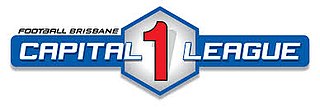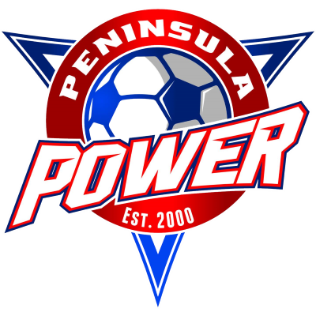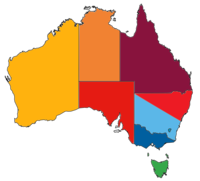
Taringa Rovers is an Australian soccer club based at Indooroopilly, in the west of Brisbane, Australia. The club was founded in 1949 by Jack Speare and Ernie Dixon.

Eastern Suburbs Football Club is an Australian soccer club from East Brisbane, Queensland, Australia. The club is the most centrally located of all the semi-professional clubs in Brisbane, situated approximately 2.7 kilometres (1.7 mi) from the city centre. Easts competes in the Brisbane Premier League, in both the men's and women's competitions, and play their home games at Heath Park, East Brisbane.

Wynnum Wolves Soccer Club, Wolves FC, or WDSC Wolves FC, is a soccer football club with our home grounds in Boundary Street, Tingalpa, Brisbane, Australia. Founded in 1921, the club has a long tradition and currently competes in he Football Queensland Premier League.

Souths United Football Club is an Australian football (soccer) club based in Runcorn, a southern suburb of Brisbane, Queensland. The club was formed in 1962, and currently competes in the Brisbane Premier League. In May 2017, Football Queensland announced Souths United FC were among the 14 clubs accepted to form the Football Queensland Premier League for its initial season in 2018.

Capital League 1 is the second tier of men's senior football (soccer) in Brisbane, Queensland and Level 5 within the Australia. It is administered by Football Brisbane. All clubs participating in Capital League 1 must field two teams, one in first grade, and another in the reserves competition. Clubs in the NPL and Brisbane Premier League cannot field their reserves teams in this division.

Albany Creek Excelsior Football Club is an Australian football (soccer) club from Albany Creek, a suburb of Brisbane, Queensland, Australia. The club was formed in 1963, and currently play in Brisbane Premier League.

Peninsula Power is an Australian football (soccer) club from Redcliffe, Queensland. The club was formed in 2000 following a merger of the Redcliffe City and Margate soccer clubs. The club currently competes in the Brisbane Premier League. In May 2017, Football Queensland announced Peninsula Power FC were among the 14 clubs accepted to form the Football Queensland Premier League for its initial season in 2018.

Newmarket Soccer Football Club is an Australian football (soccer) club based at Newmarket, an inner north-west suburb of Brisbane, Queensland. The club was founded in 1949 as the Postal Institute Soccer Club, adopting its current name in the mid-1960s. The men's senior team currently competes in Football Brisbane's Capital League 2. Newmarket SFC play in a gold strip (home) and a maroon strip (away). The club's logo has remained the same since foundation and depicts the Greek God Hermes, the patron and protector of athletes and messenger of the gods.

Kangaroo Point Rovers FC is an Australian football (soccer) club from Brisbane, Queensland. The club was formed in 1996 and currently fields first and reserve grade teams in Football Brisbane's Capital League 2 competition, and competes in the Men's City League and the Brisbane Women's competitions.

Pine Hills FC is an Australian football (soccer) club based in Bunya, Queensland. The club currently competes in Brisbane's Capital League 1.
The 2015 Football Queensland season was the third season since NPL Queensland commenced as the top tier of Queensland men’s football. Below NPL Queensland is a regional structure of ten zones with their own leagues. The strongest of the zones is Football Brisbane with its senior men’s competition consisting of five divisions.

Toowong FC is an Australian football (soccer) club based in Auchenflower, Queensland, Australia. The club was established in 1921, and currently plays in the Football Brisbane Men's Premier League, Women's Capital League and City League competitions. The club also has junior teams for all ages with a strong focus on female participation.

Oxley United is an Australian football (soccer) club based in Corinda, Queensland. The club was established in 1913 and is the oldest extant club in continuous existence in the Brisbane region. Oxley United had its golden age in the late 1950s and early 1960s, winning the Brisbane First Division in 1958, and competing in Australia's very first national cup competition, the 1962 Australia Cup. Oxley United FC currently competes in the Capital League 2 competition.
The 2016 Football Queensland season was the fourth season since NPL Queensland commenced as the top tier of Queensland men’s football. Below NPL Queensland is a regional structure of ten zones with their own leagues. The strongest of the zones is Football Brisbane with its senior men’s competition consisting of five divisions.

Holland Park Hawks FC is a football club based in Camp Hill, Queensland. They have competed in the Brisbane Premier League since achieving promotion from Capital League 1 as champions in the 2015 season.

Capital League 2 is the third tier of men's senior football (soccer) in Brisbane, Queensland and Level 6 within the Australian soccer league system. It is administered by Football Brisbane. All clubs participating in Capital League 2 must field two teams, one in first grade, and another in the reserves competition. Clubs in the NPL and Brisbane Premier League cannot field their reserves teams in this division.

The Gap FC is an Australian football (soccer) club from The Gap, a suburb of Brisbane. The club was formed in 1955, and currently competes in the Brisbane Premier League. The club's distinctive gold and purple colours have been with the club since its earliest days and derive from the name of the suburb.

Moggill FC is an Australian football (soccer) club from Bellbowrie, a suburb of Brisbane. The club was formed in 1974, and currently competes in Capital League 1.
Capital League 4 is the fifth tier of men's senior football (soccer) in Brisbane, Queensland and Level 8 within the Australian soccer league system. It is administered by Football Brisbane. All clubs participating in Capital League 4 must field two teams, one in first grade, and another in the reserves competition. Clubs in the NPL and Brisbane Premier League cannot field their reserves teams in this division. This division was the lowest in the Football Brisbane structure in 2017, was not required in 2018 following a restructure of Queensland football which resulted in many Football Brisbane clubs joining the newly formed Football Queensland Premier League.





















